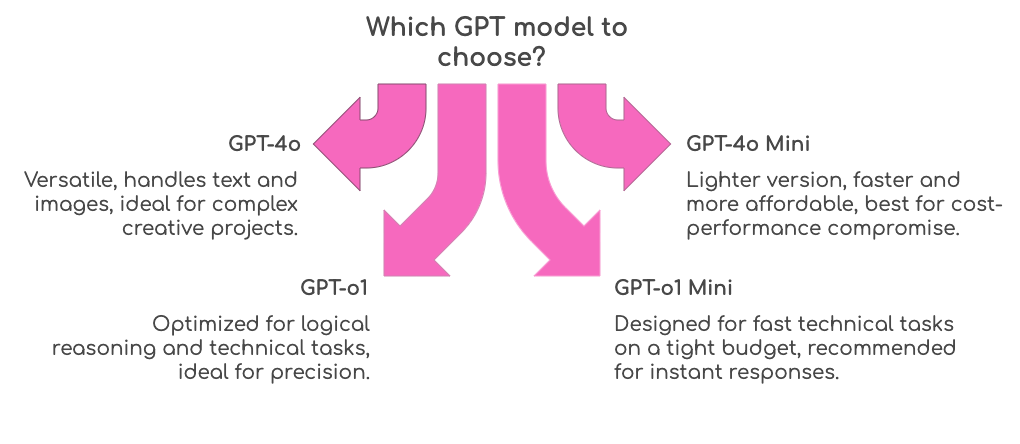GPT-4o, GPT-o1, GPT Canvas… Not easy to find your way around all these versions of ChatGPT. Each model has its strengths, its particularities, and it’s not always easy to know which one to choose. Whether you need an AI capable of handling large amounts of text or analyzing images, this guide helps you understand the differences between each model and find the one that’s just right for your projects.
Main models available in 2024
Before detailed comparisons, it’s essential to understand each model and what it can offer.
In short: which model to choose?
To help you make a quick choice, here’s a summary of the essential points:

- GPT-4o: Ideal for complex creative projects, capable of handling both text and images. Perfect if you need versatile AI and a large pop-up window.
- GPT-4o Mini: Lighter version of GPT-4o, still multimodal, but faster and more affordable. It’s the best choice for a compromise between cost and performance.
- GPT-o1: Optimized for logical reasoning and technical tasks. Ideal for developers and analysts who need precision.
- GPT-o1 Mini: Designed for fast technical tasks on a tight budget. Recommended for developers requiring instant responses.
- GPT Canvas: Collaboration-oriented version, perfect for content creation or coding assistance. Still in beta, it may lack maturity compared to the others.
GPT-4o
The GPT-4o model represents the culmination of OpenAI’s advances in GPT technologies, launched in March 2024.
This optimized version offers advanced functionality, including multimodal interaction capable of handling text, voice and images equally well.
Unique capabilities:
- Advanced multi-modality: Handles and responds to queries containing both text and images, making it ideal for creative tasks or visual content analysis.
- 128k tokens context window: Ideal for projects requiring large amounts of contextual data.
- Limit of 16,384 tokens per request : Perfect for complex applications requiring detailed responses.
When to use this template
Ideal for creative or complex projects, such as image analysis, large-scale report generation, or task management requiring broad context.
My opinion:
If you need a versatile AI, capable of processing large amounts of information while also being able to understand and analyze images, GPT-4o is the option of choice.
It’s particularly suited to complex environments, such as rich content creation, video game development, or sophisticated interactive applications.
GPT-4o Mini
Launched in July 2024, GPT-4o Mini is a more accessible version of GPT-4o, offering similar power at a reduced price.
Although optimized for speed and efficiency, it retains the multimodal capabilities that are the strength of its older sibling.
Unique capabilities:
- Multimodality: Like GPT-4o, it handles both text and images.
- Context window of 128k tokens: Enables processing of data volumes similar to GPT-4o.
- Optimized for efficiency: Responds faster and at lower cost, ideal for projects with budget or time constraints.
When to use this template
For companies or developers seeking a balance between performance and cost, while requiring multimodal capabilities.
My opinion:
This model is an excellent option if you’re looking to integrate advanced capabilities while cutting costs.
However, if your projects require even faster processing and multimodality is not essential, GPT-o1 might be more suitable.
GPT-o1
Deploying in September 2024, GPT-o1 is designed to provide advanced reasoning and logic capabilities.
This model is less focused on multimodality, but excels in analytical and technical tasks.
Unique capabilities:
- Specialization in logical reasoning: Ideal for applications requiring advanced thinking skills, such as programming or solving complex mathematical problems.
- Context window of 8k tokens : Sufficient for well-targeted technical tasks.
- Maximum limit of 4,096 tokens per request: A good compromise between efficiency and precision for specific tasks.
When to use this template
Software development, debugging, data analysis, strategy and any technical task requiring precise reasoning.
My opinion:
GPT-o1 is perfect for technical tasks requiring superior reasoning ability.
If you’re a developer, analyst or engineer, this model will be more suitable than the multimodal versions.
GPT-o1 Mini
Launched in April 2024, GPT-o1 Mini is the slimmed-down version of GPT-o1, optimized for speed while offering reliable performance for technical tasks.
It’s designed to meet urgent needs without compromising accuracy.
Unique capabilities:
- 4k tokens context window: Perfect for quick technical tasks.
- Limit of 2,048 tokens per request : Sufficient for concise technical analysis.
- Optimized for speed: Guarantees fast responses without sacrificing accuracy.
When to use this template
Real-time programming assistance, debugging, or any application requiring urgent technical responses.
My opinion:
If speed is essential to your project, GPT-o1 Mini offers an excellent compromise between cost, performance and response time.
This model will be ideal for developers or analysts needing fast assistance in their daily work.
GPT Canvas
GPT Canvas, currently in beta, is positioned as a collaborative AI, designed to support users in writing and creating code.
It has limited multimodal capabilities, but is primarily geared towards assisted authoring.
Unique capabilities:
- Multimodality: Limited but effective processing capabilities in certain creative scenarios.
- Context window of 10k tokens: Sufficient for writing projects or code development.
- Limit of 6,000 tokens per request: A good compromise for man-machine collaborative projects.
When to use this template
Assistance tool for content creation (article writing, scripts) and code project development.
My opinion:
GPT Canvas is an excellent choice for creative or coding projects. However, being in beta, it may lack the maturity and reliability of other more mature versions.
Technical comparison
To make the decision easier, here’s a table comparing the key features of each model:
| Model | Multimodal | Max Tokens | Context Window | Release Date | Highlights | Best Use |
|---|---|---|---|---|---|---|
| GPT-4o | Yes | 16,384 | 128k | March 2024 | Advanced capabilities, large contextual window | Creative and complex projects requiring multimodality |
| GPT-4o Mini | Yes | 16,384 | 128k | July 2024 | Profitable, optimized for efficiency | Projects with budget constraints requiring multimodality |
| GPT-o1 | No | 4,096 | 8k | September 2024 | Advanced logical reasoning | Technical tasks, development and data analysis |
| GPT-o1 Mini | No | 2,048 | 4k | April 2024 | Fast technical responses | Technical tasks requiring speed |
| GPT Canvas | Yes | 6,000 | 10k | Beta 2024 | Writing and code assistance | Collaborative creative projects |
How to choose the right model for your needs?
Here are some factors to consider when choosing your ChatGPT template

- Nature of task: For projects requiring high analysis and multimodal processing capacity, GPT-4o or GPT-4o Mini are the ideal choices.
For logical and technical capabilities, favor GPT-o1. - Budget: If cost is an important consideration, Mini versions offer respectable power at a more competitive price.
- Multimodality: If you work with images in addition to text, opt for multimodal templates such as GPT-4o, GPT-4o Mini or GPT Canvas.
- Speed of response: For tasks requiring fast, concise responses, GPT-o1 Mini or GPT-4o Mini are the best options.
- Context size: If your projects require processing large volumes of data, GPT-4o and GPT-4o Mini are the preferred models with their wide context window.
Conclusion
The choice of the right ChatGPT model depends largely on your specific needs. The GPT-4o and GPT-o1 models are designed to meet very different requirements.
If you’re looking for an AI capable of handling both images and text with broad context, GPT-4o is your best bet.
For more technical tasks requiring advanced reasoning, GPT-o1 is to be preferred.
Taking the time to properly assess your needs will enable you to select the model that will optimize your results while respecting your budgetary and technical constraints.
FAQ
- Which is the fastest model?
GPT-o1 Mini is optimized for speed, especially in technical tasks. - Which to choose for creative tasks?
GPT-4o or GPT Canvas are best for creative, multimodal projects. - Which is the most affordable model?
The Mini versions, such as GPT-4o Mini and GPT-o1 Mini, offer an excellent compromise between cost and performance. - Which is better for programming?
GPT-o1 and GPT-o1 Mini perform best for programming and technical tasks. - Is GPT Canvas reliable?
GPT Canvas is in beta version, so its performance may yet evolve. - Can I use GPT-4o for real-time projects?
Yes, but GPT-4o Mini might be more suitable due to its speed. - Which version is best suited for complex analysis?
GPT-4o excels in tasks requiring complex data analysis thanks to its high processing capacity. - Is GPT-o1 suitable for non-technical users?
GPT-o1 is primarily designed for technical tasks, but remains accessible for users looking to solve logical problems. - Can I use GPT-4o for non-multimodal tasks?
Yes, although it’s optimized for multimodal, it’s still very capable for text-only processing. - Are Mini versions less powerful
No, they are optimized to deliver high performance while reducing the cost and resources required.
AI NEWSLETTER
Stay on top of AI with our Newsletter
Every month, AI news and our latest articles, delivered straight to your inbox.

CHATGPT prompt guide (EDITION 2024)
Download our free PDF guide to crafting effective prompts with ChatGPT.
Designed for beginners, it provides you with the knowledge needed to structure your prompts and boost your productivity
With this ebook, you will:
✔ Master Best Practices
Understand how to structure your queries to get clear and precise answers.
✔ Create Effective Prompts
The rules for formulating your questions to receive the best possible responses.
✔ Boost Your Productivity
Simplify your daily tasks by leveraging ChatGPT’s features.
Similar posts
GPT-4o vs. GPT-4o-mini: which AI model to choose?
OpenAI has recently introduced two new models that are generating a lot of interest: GPT-4o and GPT-4o-mini. Although these models share a common technological base, they are designed to meet …
ChatGPT Canvas : The new interface for writing and coding with ChatGPT
You thought OpenAI was on the wane? 😉 After recent announcements that may have disappointed some people’s expectations, OpenAI continues to push the boundaries of its chat tool, with the …
ChatGPT 3.5 and ChatGPT 4 : What are the differences ?
The transition between ChatGPT 3.5 and ChatGPT 4 has opened new doors to more complex and rewarding interactions. Let’s dive intothe features that distinguish these two versions and discuss recent …


